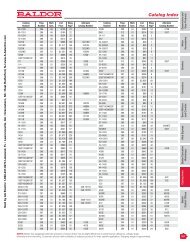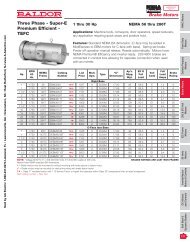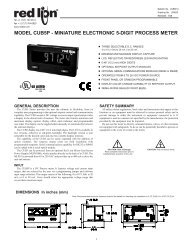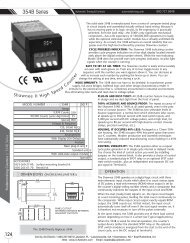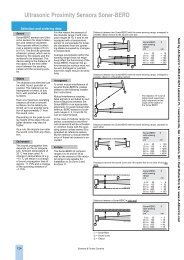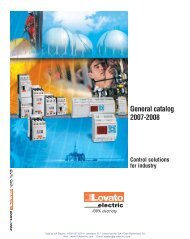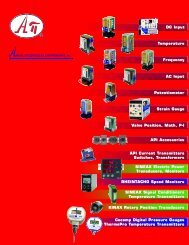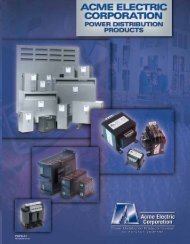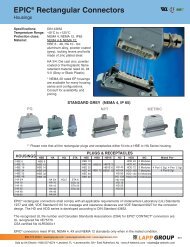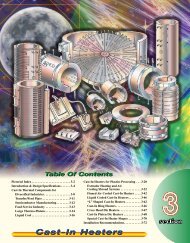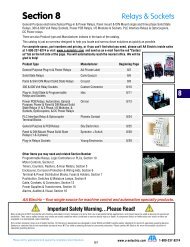Data Sheet - ComDaC
Data Sheet - ComDaC
Data Sheet - ComDaC
Create successful ePaper yourself
Turn your PDF publications into a flip-book with our unique Google optimized e-Paper software.
Anderson Power Products®<br />
Genderless Connector<br />
Wiping action on mate and break<br />
keeps conducting surfaces clean<br />
Detent keeps connectors mated and provides<br />
quick break snap action upon disconnect<br />
Rugged lightweight<br />
polycarbonate housing<br />
If broken under load, arcing is confined to tip a non-conducting area<br />
Low resistance silver or<br />
tin-plated copper contacts<br />
Stainless steel leaf spring provides constant contact pressure<br />
Where Do Contacts Contact?<br />
Although electrical contacts appear to have a large surface area,<br />
only a small portion of that area actually touches the mating part,<br />
because any metal surface — no matter how finely polished or<br />
ground — is never perfectly flat or smooth.<br />
What Makes A Good Connector?<br />
The termination can make the difference between good and poor<br />
connector continuity. This hypothetical example of “good” and<br />
“poor” continuity shows how power loss can seriously impair the<br />
efficiency of an EV. Important are two points of resistance:<br />
Mating Surface<br />
Mating summits or asperities<br />
Peaks on<br />
flat surface<br />
The butt contact conducts<br />
current via three or less<br />
summits or high peaks<br />
(asperities).<br />
1. Rc, the central contact resistance.<br />
2. Rw1 the resistance at two terminations.<br />
A typical sliding connector carries 175A, but when the termination<br />
resistance Rw, rises because of faulty design or assembly, total<br />
resistance rises, too. (See table). Using the basic relationship for<br />
DC power,<br />
P= (I x R) (I) = I²R<br />
Mating Cross Section<br />
Asperities (individual mating spots)<br />
The cylindrical contact,<br />
although it appears to have a<br />
large, ample area, actually<br />
conducts current through no<br />
more than three lines of<br />
contact in this example.<br />
The “good” conductor dissipates, or loses,<br />
P = (175)² (0.00004) = 1.225W<br />
The “poor” conductor loses,<br />
P = (175)² (0.00202) = 61.8W<br />
R w R c R w<br />
Mating line<br />
The sliding contact, when<br />
spring loaded, conducts<br />
current through an entire line<br />
of contact.<br />
Good vs. Poor Connection<br />
Typical Joint R w R c R w R total<br />
Good 0.000010 0.000020 0.000010 0.000040<br />
Poor 0.001000 0.000020 0.001000 0.002020<br />
HEADQUARTERS: 13 Pratts Junction Road, P.O. Box 579, Sterling, MA 01564 T:978-422-3600 F:978-422-3700<br />
EUROPE: Rathealy Road, Fermoy Co. Cork, Ireland T:353-(0)25-32277 F:353-(0)25-32296<br />
ASIA/PACIFIC: IDEAL Anderson Asia Pacific Ltd., Unit 922-928 Topsail Plaza, 11 On Sum Street, Shatin N.T., Hong Kong T:852-2636-0836 F:852-2635-9036<br />
CHINA: IDEAL Anderson Technologies (Shenzhen) Ltd., Block A8 Tantou W. Ind. Par, Songgang Baoan District, Shenzhen, PR. China 51810 T: 86-755-2768-2118 F: 86-755-2768-2218<br />
TAIWAN: IDEAL Anderson Asia Pacific Ltd., Taiwan Branch, 4F.-2, No.116, Dadun 20th St., Situn District, Taichung City 407, Taiwan (R.O.C.) T: 886-4-2310-6451 F:886-4-2310-6460<br />
www.andersonpower.com<br />
- 2 -



